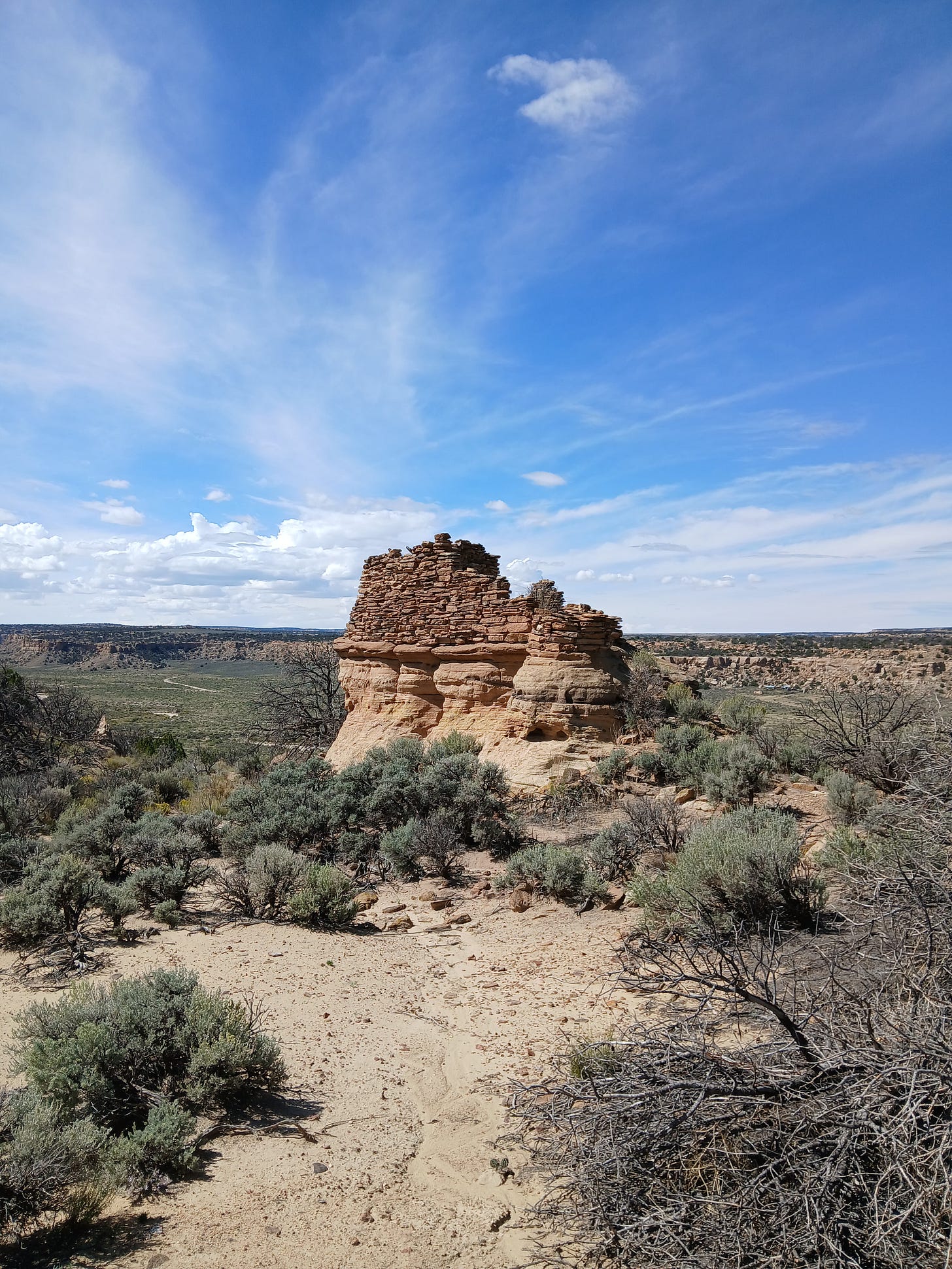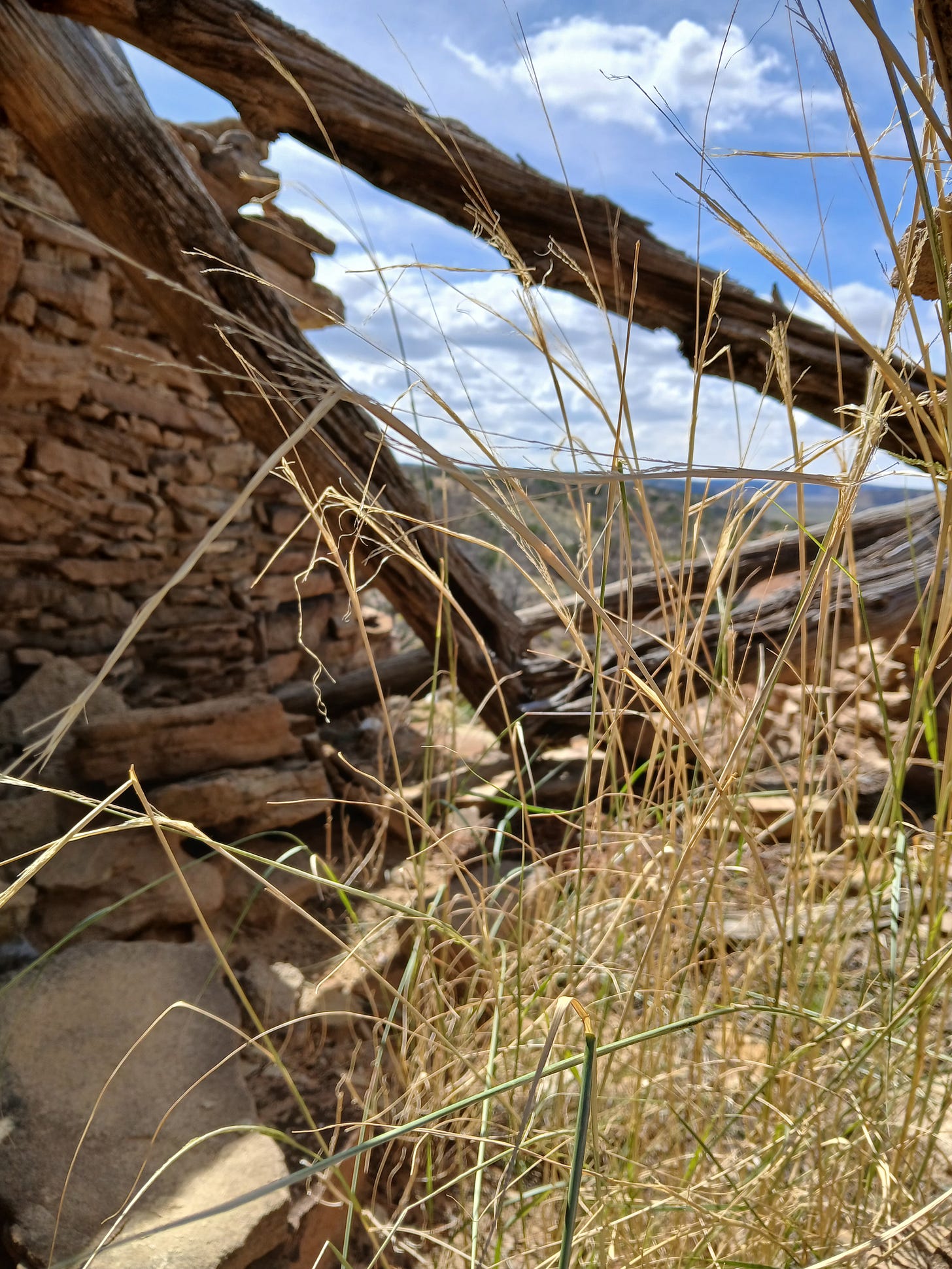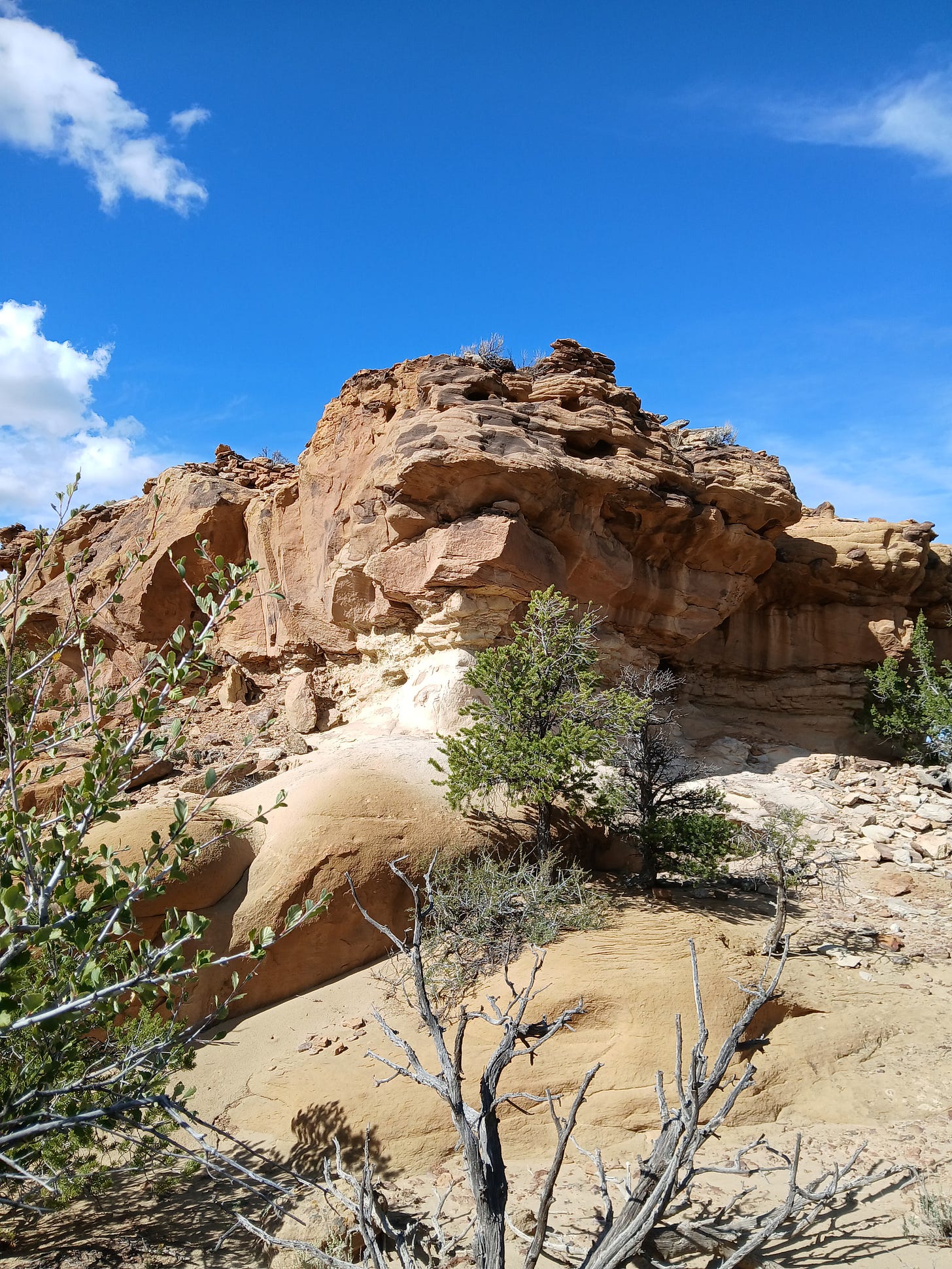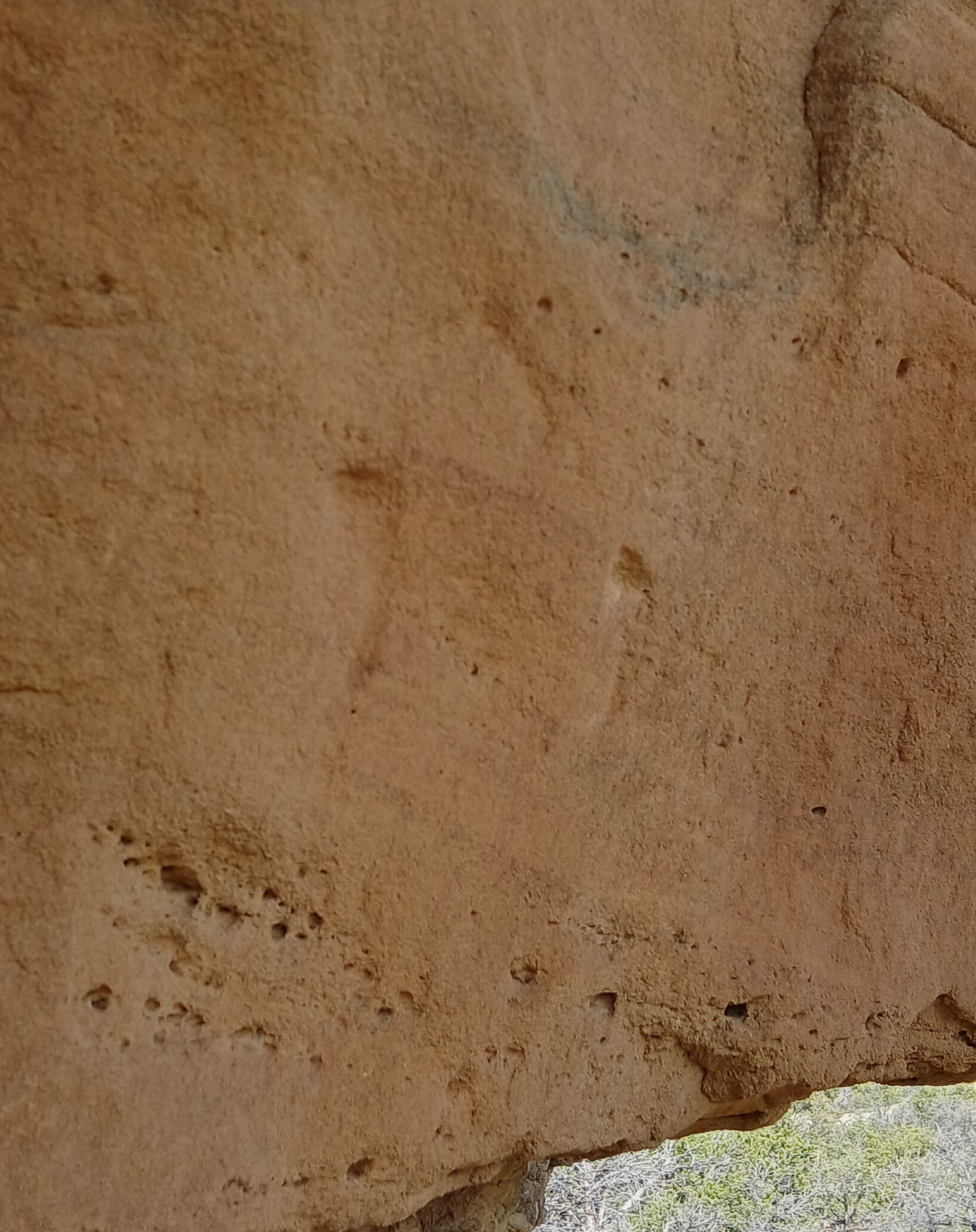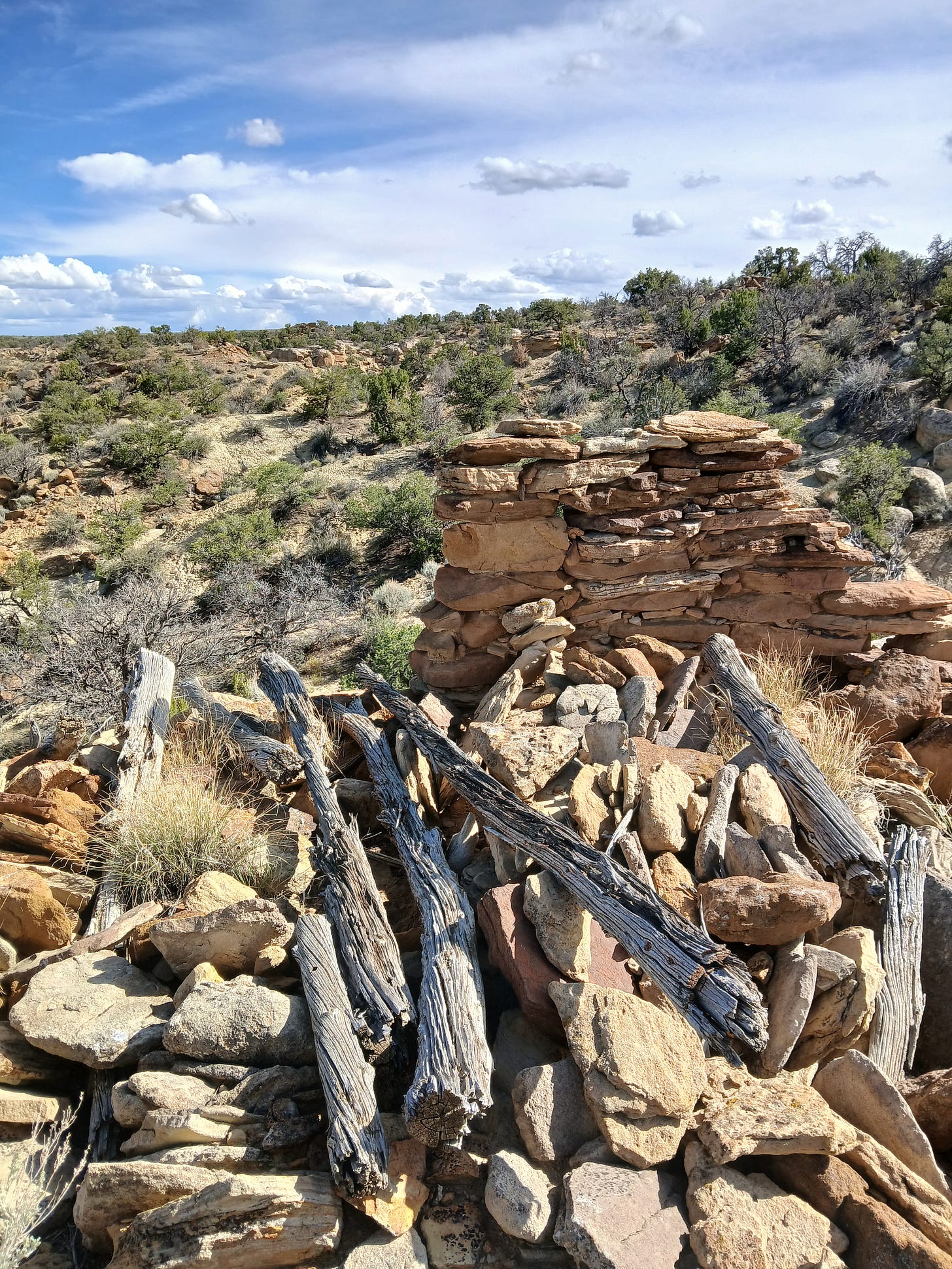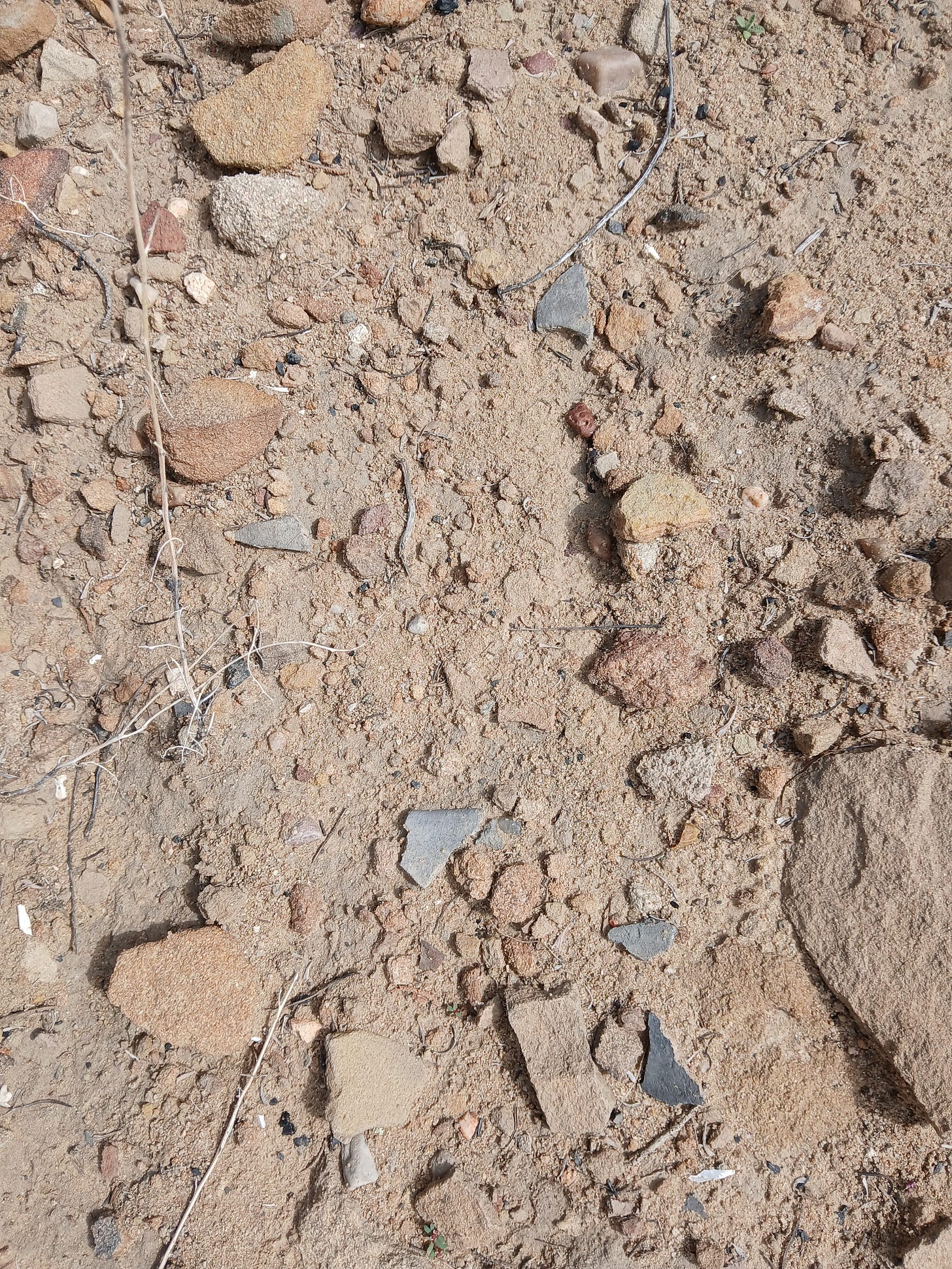Tracing the Path of Modernity in the Navajo Pueblito's Shadow
Reading Early Modern History and the Fossil Fuel Present in the Traces of the Dinetah
Scattered along mesa tops running from the southern end of Largos Canyon—a broad remote valley edged by brightly colored sandstone bluffs running north across the northern edge of New Mexico’s San Juan Basin—south to the San Juan River are the ruins of small fortified structures built into the contours of the mesas, almost disappearing into the landscape. In a region with a long history of human occupation, going back at least twenty thousand years, and an incredible density of ancient built structures, one might suppose these structures, like the one below I visited last week during an expedition across northwest New Mexico, Canyon View Pueblito, to be quite old. However, they are—relative to other nearby ancient sites—young, dating to the seventeenth and eighteenth centuries (ages that in much of the rest of the United States would make them among the oldest extant structures of any sort, but the Southwest is a very different sort of place on that front).
And while at first glance they resemble the better-known and considerably older great house and other structures of the nearby Chacoan cultures, or the more recent pueblos of the Rio Grande valley, these pueblitos as they are known were built by Navajo people, during a period of early modernity marked by massive and frequently violent cultural transformations, playing out on a global scale. There is, as incredible as it may seem, a direct connection between the historical dynamics that led to the construction of these seemingly ancient looking structures in the remote desert Dinetah (the ancestral New Mexican Navajo homeland, centered on the long north-running Largo Canyon) and the histories of far-distant lands across the earth, from the Ottoman to the Qing to the Holy Roman empires.
But history has not stood still in these remote canyons and mesas: it is not just the traces of early modernity that can be descried with startling clarity thanks to the desert’s preservative qualities. Like many other now remote and uninhabited corners of the West—but particularly New Mexico with its especially rich and long history of human habitation and connectivity with Mesoamerica to the south—it is only in recent years that the landscape has been so thoroughly depopulated. I am not sure when the last people left Largo Canyon, but it wasn’t that long ago. I poked around in the ruins of a ranch house that showed signs of renovation work from the 1960s; it might not have been finally abandoned until some point within my lifetime. Near the Canyon View Pueblito, in fact just one side canyon over, is an early 20th century homestead, the Margarita Martinez Homestead, itself a condensation of many threads of modern history, slowly—very slowly, fortunately—crumbling back into the desert. Other similar sites are scattered up and down the canyon, which at its height had about two hundred inhabitants, a mixture of Hispanic, Navajo, and Anglo Americans. By the mid-twentieth century virtually all of them had left, and as of today almost all of the region is Bureau of Land Management property.
It is not, however, wilderness. To get to the historical sites scattered around the upper end of the canyon, I drove on surprisingly good dirt roads, wider and smoother than I am used to navigating back home in our national forests. As I climbed the precarious mesas to get to the little pueblitos alongside the sounds of the sagebrush desert and the pinyon-juniper woodlands there was a constant background industrial hum: at Canyon View that of a natural gas pumping station, a steady buzz of machinery, while at a second pueblito, Hummingbird House, it was the clack-clack-clack of an oil rig swinging up and down, up and down, echoing across the canyon and onto the mesa tops. Perhaps once every hour or two a utility truck or a massive tanker would creep down through the canyon, kicking up dust and disappearing down the bend of the canyon. Largo Canyon is not unusual in this regard. The entirety of the northern San Juan Basin, one of the most remote and lightly populated parts of the continental United States, has been restructured by the infrastructure of fossil fuel extraction. And where the Native architecture of this place, from the soaring great houses of Chaco to the defensive pueblitos of the Dineyah, was built to blend into and mirror the natural landscape, the pumping stations and road and oil pumps make no such efforts, no concessions to aesthetic or artistic concerns. They acknowledge neither God nor spirits, structured entirely by the desire to maximize shareholder value. The irritating background noise is the true cadence of industrial capitalism, distilled into its purest essence, running most of the time without any human intervention whatsoever.
This landscape then, as improbable as it may seem, is a palimpsest of modernity, from its origins in the age of global empires and vast movements of peoples and makings of cultures down to the bleak present of fossil fuel centered “civilization.” In what follows I’ll look more closely at some aspects of the specific history revealed here and where it leaves us in the present. I’d like to follow this essay up with a couple of others based on my brief sojourn in northwest New Mexico, specifically thinking through the Chacoan culture’s relationship to the land and the natural and more-than-natural worlds, a relationship that presents just about the most striking contrast with that of our own of which I know. But for today, let us return to the mesa-top pueblitos.
I had not originally planned to visit the Navajo Dinetah. After spending time in Chaco Canyon I had intended to continue south across the desert and make a loop east back to Albuquerque; however after talking with a park ranger about the condition of the road south from Chaco—thirty miles of rough washboard, worse than the road coming down from the north—I decided not to subject my already over-taxed rental car to such conditions and instead explore the area north of Chaco some more. On my return drive back south I made a somewhat last minute decision to veer off of the region’s one paved road and drive down into Largo Canyon and look for its historic sites, keeping an eye on the distant clouds in case I needed to beat a fast retreat before the sandy washes filled with water and I ended up staying much longer than intended.
I had learned the location of the Navajo pueblitos earlier so locating them was not especially difficult (you can learn about individual sites and the wider history through this linked-to study put out by the BLM). Those further north near the San Juan River are quite publicly accessible if not well known; the two that I visited at the southern edge of the Dinetah are not particularly accessible and get very few visitors indeed. I descried from the canyon floor a third pueblito but could find no way up the mesa cliffs other than a rickety old ladder that appeared to be older than me. I chose not to test its integrity. The two pueblitos I managed to visit both involved surveying the cliffs and finding the least difficult access points, in both cases involving moderate hand-over-hand climbing. In both cases I had to use my GPS to find their exact locations, as they were not situated to attract attention. Hummingbird House was the harder of the two: perched on an eroded projection of the mesa, it can only be accessed up a crack provided with carved footholds, and once covered over with a protecting gate. The wall remnants are barely visible from even a close distance, and invisible from the canyon floor. Canyon View stood out more, built atop an isolated sandstone projection, but drawn in from the mesa edge and hard to descry from below.
There are hundreds of pueblitos in this region of New Mexico, their greatest density in a region running from near the Colorado line down almost to US 550, almost all of them similar in their locations high atop the mesas. The Navajo had settled in these canyons at some point in the late medieval to earliest early modern period, probably, moving down from points north into a landscape that was at the time uninhabited, the Chacoan peoples having moved out to more arable locations during the thirteenth century. While the initial Navajo movement south into what would become the Dinetah was not connected with the global dynamics of the early modern world, they would soon encounter that wider world. The first Spanish entrada into New Mexico took place in the 1540s, with sustained settlement only really getting underway at the start of the 17th century. The Rio Grande valley and the Pueblo communities in and around it became the northernmost frontier of the global Spanish empire, linked however tenuously back to central Mexico and world-wide routes of empire, trade, and other forms of circulation. But even before Spanish rule became manifest visibly, globalized circulation routes were changing the deserts and mountains of New Mexico, seeping into the remote Dinetah where the Navajo had adapted Puebloan farming practices and aspects of ritual and cultural life to their own purposes. Two elements were especially important here and across the American West: diseases and horses. The spread of novel diseases was probably the most important legacy of the first Spanish entradas, here and everywhere. Second in importance was the also inadvertent (re-)introduction of horses, whose use by nomadic groups like the Ute, Apache, and Comanche would vault them to new prominence and power. Where a more or less stable relationship had once existed between more nomadic groups and the solidly sedentary, broken by fairly limited bouts of raiding, the introduction of horses meant that nomadic groups could carry out highly effective raids on their neighbors and carry off far more loot than before.
All of these factors, combined with Spanish attempts—and failures—at subjugating the Puebloan peoples, led to a successful 1680 revolt by the Puebloan peoples which, for a time at least, drove the Spanish out of the region. However, they soon returned and re-established control, at least over the Puebloan peoples, if not over their nomadic raiding neighbors. It was this fraught historical context that drove the creation of the Navajo pueblitos: while not adverse themselves to raiding their neighbors, the Dinetah was threatened by incursions from other Native groups such as the Ute and Comanche as well as punitive expeditions on the part of the Spanish, whose empire bled out along the ragged edges of the San Juan Basin, not yet really penetrating it. The pueblitos were built primarily, it appears, as places of refuge, though some also clearly functioned as dwelling places: the floor and surface around Canyon View Pueblito, for instance, has a quite the scatter of pottery sherds, indicative of domestic use. I imagine that someone used to the mesa and canyon sides could scramble up and down from pueblito to dry farming fields below with relative ease. Others, including the one-roomed tower I observed from the canyon floor but could not reach, were very clearly strictly defensive, places of refuge when Native or Spanish raiders appeared on the horizon.
During the latter half of early modernity the Navajo would gradually shift to a more pastoral economy, one for which they are best known today (and which, along with the pastoral practices of their Hispanic and Anglo neighbors, has had immense ecological effects of its own, though that is another story). During the early nineteenth century the pueblitos were largely abandoned as the center of Navajo life shifted west, in turn being deeply disrupted by a new empire, the American one, whose military presence would only increase as the century unfolded. By the time that people—including Navajos!—began to resettle Largo Canyon in the mid-nineteenth century the pueblitos had laid empty for some years, and it took time for external observers to reconstruct their original purpose and surmise who their builders were.
Even as the Navajo fortified their homeland against the various early modern threats from outside, they continued a process of meaning-making in relation to the landscape, one that was consciously in continuity with vastly older relationships and forms of use. While I was unable to visit the main petrogylph and pictoglyph sites in the Dinetah on this last trip—they were further north down worse roads—I visited panels in Chaco Canyon to which Navajo added their own images, and found a pair of—faint—petroglyphs on the stone under Hummingbird House, which may well predate the Navajo occupation:
These sites and their immediate surroundings were in many cases not simply utilitarian but had ritual purposes as well, and helped to form an emergent cultural and religious landscape, one that can be descried in the Diné Bahaneʼ, the Navajo creation and origin mythic cycle. The Navajo, speakers of a Na-Dené language with origins much chronologically closer to Eurasia than other Native peoples of North America (though still on the order of five to nine thousand years ago!), while relative newcomers to the region did not start from scratch. Instead the sacred landscape they developed was one frequently in continuity with that of the ancestral Puebloans: Chaco Canyon was a spiritually significant place to early modern Navajo, and their early contacts with and indeed eventual partial integration of some refuge Puebloan peoples contributed to further cultural continuities. Even as the Navajo with increasing thoroughness became part of the globalized early modern world, pushed and pulled along the circulation routes of empire, they were also consciously inhabiting a much, much older landscape and perpetuating practices that reached deep into the past.
The Navajo of the Dinetah were far from being the only early modern people whose lives were being shaped by imperial expansion and global routes of circulation. Across North America peoples who were not under direct or even indirect European rule were being shaped by global dynamics thanks to imperial interventions. The lives of desert-dwellers in Afro-Eurasia were also being transformed by similar contours and routes of empire: contemporary with the Navajo pueblito-builders the Kurds of the marginal lands of the Ottoman Empire, for instance, were being integrated into new global patterns of trade and consumption, with new commodities like coffee and tobacco reworking social life and even spatial experience at the same time the Navajo were building their pueblitos and adapting livestock herding, moving towards a mode of life and ecology that would be immediately recognizable to early modern Kurds or other nomadic and semi-nomadic peoples of the Islamicate world. And in one of those fantastic examples of convergence that is not directly related, Ottoman pilgrims were writing or incising their names and prayers and sacred formulas on the surfaces of holy places at the same time that Navajo pilgrims on the other side of the world were doing the same, albeit without alphabetic writing.
If the Navajo pueblitos can be seen as the material effects—significant, but not totalizing—of early modern empire’s outer expansive frontier, the modern landscape in which they now sit displays a very different relationship to contemporary empire. Underneath the San Juan Basin there are massive reserves—to use the language of capitalist extraction—of fossil fuels, coal, oil, and natural gas, with its coal-bed methane field the largest not just in the United States but in the entire world, with its more conventional natural gas of global significance as well. Most of these fossil fuels are the product of the late Cretaceous as the great Western Interior Seaway—which once formed a single ecological unit linking, among other places, the Cretaceous landscape of my own birth in east central Mississippi with the deserts of New Mexico. As the seaway filled with sediment and gradually ceased to be a seaway its margins turned into vast forested bottomlands, not unlike much of the contemporary Deep South. The coal into which those wetlands were transformed has in turn generated the methane, and that methane has drawn the full force of fossil fuel capitalism to Largo Canyon along with seemingly every single canyon and mesa across the northern half of the basin.
It is hard to convey the scale of this extractive infrastructure, or its incongruity with the surrounding landscape. Gas pumping stations and oil wells squat in the midst of otherwise wild badlands, spread out over valley floors and mesa tops, cling to the sides of desert washes. The ambient noise of all of these operations creates an almost continuous archipelago of islands of industrial sound, becoming an omnipresent background hum, or worse, in the Largo Canyon area and elsewhere. I wonder if the last ranchers to leave were not finally driven off by that constant noise, the predecessor to today’s satanic low roar of the data centers now devouring landscapes and energy across America.
Fossil fuels are at the heart of American empire, are the heart of American empire. Our vast wealth and power exist because of those Cretaceous and Paleocene and Permian wetlands buried under tens and hundreds of millions’ of years of sediment, because of the sprawling network of extraction, of legal protections, and ultimately of the violent force at home and abroad that protects extraction and guards the global routes of supply and market that keep the economic engines running. If the early modern Spanish empire’s inroads into these canyons and mesas was sporadic and more a matter of effects from the outside, of resources and pathogens and ideas released and more or less randomly circulated, fossil fuel empire is direct and total, literally sucking the earth dry of oil and gas and vomiting the pollution into the atmosphere, changing the course of geological history in the process.
The contrast in ways of life and attitudes towards the land and the spiritual world between that of the Dinetah Navajo and of modern American fossil fuel capitalism are in utterly stark relief here. Where Navajo interventions, from the pueblitos to rock art to the dry land farm fields and gardens that once dotted the canyon bottoms, eased into and along the land and its contours, indeed acted almost as extensions of the landscape and natural world, fossil fuel infrastructure makes minimal such allowances. The access roads are straight lines, gashed into the landscape and laid out in vast grids. The pumps, stations, tanks, and other supporting structures are entirely utilitarian, making no concessions to aesthetics whatsoever. Economy matters, and nothing else. No one would mistake any of these devices or sites with religious sites, or wonder if they had some deeper intended meaning. The pumps and wells operate almost entirely automatically, day and night, pumping fossil fuels out into a series of nodes and processing points, ultimately bound for our vehicles, power generation stations, and all the other consumers of oil and gas upon which our capitalist economy depends. If the companies could automate the trucks that service these sites I’m sure they would, or, more likely, will, at which point the actual human presence in this landscape will be reduced to the odd traveler like myself.
As I was writing this essay I learned that a massive methane cloud—methane being one of the important drivers of global climate change—floats above the San Juan Basin, formed of escaped methane from the tens of thousands of wells piercing the earth across the basin. The high here in Chattanooga today is supposed to reach close to ninety, even though it is the first day of October; the long-term forecast is giving out warm weather well into December. Once I got back home and picked back up my computer I found myself once again watching the spectacle of the contemporary American empire and its descent into self-parodic destruction, the gutter ignorance and mindless masquerading of our dollar-store fascists itself made possible by those vast reserves of fossil fuels and the power, literal and metaphorical, that they entail when tapped and used. Part of me wouldn’t mind loading the family up and heading back out to the desert—but of course even the vast canyons and mesas of the Southwest are no escape. The numbing drone of extraction is if anything louder in the beautiful lands of the Dinetah, the inhuman material tentacles of empire have wrapped around seemingly every butte, corralled almost every badland. There is no exit, there is only the fight, or surrender.
The early modern Navajo did not ask to be a part of a world of global empires and circulation. They could not have known during their migration down into the Dinetah’s canyons and mesas and little dryland fields that at almost the same time strangers from the other side of the world were beginning to make their way north towards the same landscape. They did know that people had once inhabited this land, and they paid their respects to the many traces and numinous places those people had left, even as they sometimes raided their descendants further to the east, sometimes absorbed people from the pueblos, and took in their beliefs and myths and cultural forms to some degree. As the northernmost wave of Iberian empire washed up into the desert they had to adapt, and in so doing, survived, and indeed thrived, even as they would soon face an even more formidable imperial foe, one which they would also survive and may well again outlast. One day the empire of fossil fuels will recede from the Dinetah, but the ruins and the petroglyphs and the memory of the Diné will remain, along with the piñon and juniper and aspens and sagebrush and all the living things that make their home there still. When and why that day will come is impossible to say, but it will come, and the old sounds of the desert will once again ring in the pueblitos and rockshelters, as the gas pumps and oil wells finally fall forever silent.

